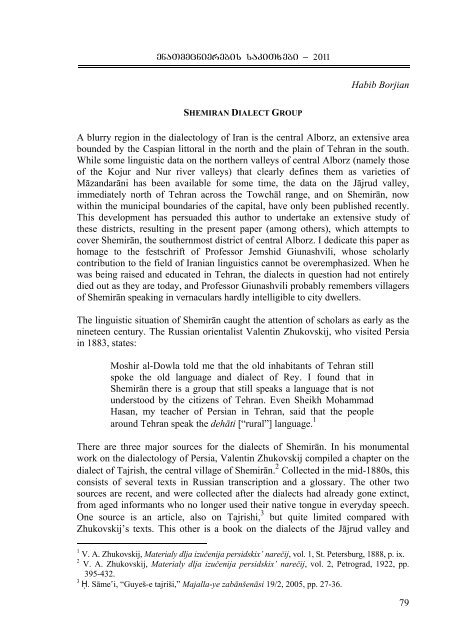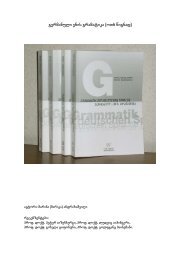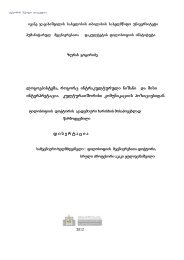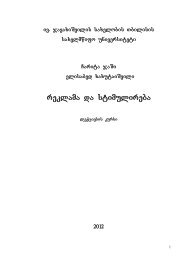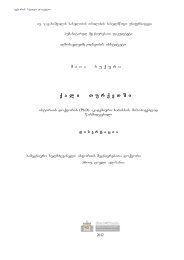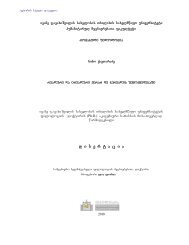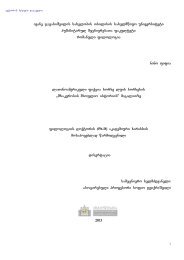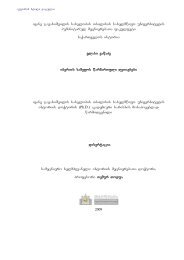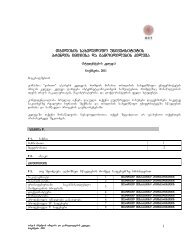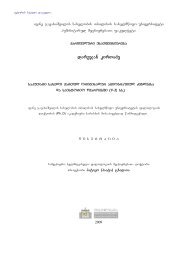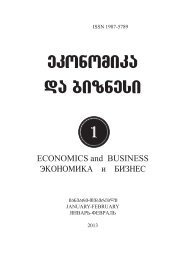issues of linguistics - Tbilisi State University
issues of linguistics - Tbilisi State University
issues of linguistics - Tbilisi State University
You also want an ePaper? Increase the reach of your titles
YUMPU automatically turns print PDFs into web optimized ePapers that Google loves.
enaTmecnierebis sakiTxebi _ 2011<br />
SHEMIRAN DIALECT GROUP<br />
Habib Borjian<br />
A blurry region in the dialectology <strong>of</strong> Iran is the central Alborz, an extensive area<br />
bounded by the Caspian littoral in the north and the plain <strong>of</strong> Tehran in the south.<br />
While some linguistic data on the northern valleys <strong>of</strong> central Alborz (namely those<br />
<strong>of</strong> the Kojur and Nur river valleys) that clearly defines them as varieties <strong>of</strong><br />
Māzandarāni has been available for some time, the data on the Jājrud valley,<br />
immediately north <strong>of</strong> Tehran across the Towchāl range, and on Shemirān, now<br />
within the municipal boundaries <strong>of</strong> the capital, have only been published recently.<br />
This development has persuaded this author to undertake an extensive study <strong>of</strong><br />
these districts, resulting in the present paper (among others), which attempts to<br />
cover Shemirān, the southernmost district <strong>of</strong> central Alborz. I dedicate this paper as<br />
homage to the festschrift <strong>of</strong> Pr<strong>of</strong>essor Jemshid Giunashvili, whose scholarly<br />
contribution to the field <strong>of</strong> Iranian <strong>linguistics</strong> cannot be overemphasized. When he<br />
was being raised and educated in Tehran, the dialects in question had not entirely<br />
died out as they are today, and Pr<strong>of</strong>essor Giunashvili probably remembers villagers<br />
<strong>of</strong> Shemirān speaking in vernaculars hardly intelligible to city dwellers.<br />
The linguistic situation <strong>of</strong> Shemirān caught the attention <strong>of</strong> scholars as early as the<br />
nineteen century. The Russian orientalist Valentin Zhukovskij, who visited Persia<br />
in 1883, states:<br />
Moshir al-Dowla told me that the old inhabitants <strong>of</strong> Tehran still<br />
spoke the old language and dialect <strong>of</strong> Rey. I found that in<br />
Shemirān there is a group that still speaks a language that is not<br />
understood by the citizens <strong>of</strong> Tehran. Even Sheikh Mohammad<br />
Hasan, my teacher <strong>of</strong> Persian in Tehran, said that the people<br />
around Tehran speak the dehāti [“rural”] language. 1<br />
There are three major sources for the dialects <strong>of</strong> Shemirān. In his monumental<br />
work on the dialectology <strong>of</strong> Persia, Valentin Zhukovskij compiled a chapter on the<br />
dialect <strong>of</strong> Tajrish, the central village <strong>of</strong> Shemirān. 2 Collected in the mid-1880s, this<br />
consists <strong>of</strong> several texts in Russian transcription and a glossary. The other two<br />
sources are recent, and were collected after the dialects had already gone extinct,<br />
from aged informants who no longer used their native tongue in everyday speech.<br />
One source is an article, also on Tajrishi, 3 but quite limited compared with<br />
Zhukovskij’s texts. This other is a book on the dialects <strong>of</strong> the Jājrud valley and<br />
1<br />
V. A. Zhukovskij, Materialy dlja izučenija persidskix’ narečij, vol. 1, St. Petersburg, 1888, p. ix.<br />
2<br />
V. A. Zhukovskij, Materialy dlja izučenija persidskix’ narečij, vol. 2, Petrograd, 1922, pp.<br />
395-432.<br />
3<br />
Ḥ. Sāme‛i, “Guyeš-e tajriši,” Majalla-ye zabānšenāsi 19/2, 2005, pp. 27-36.<br />
79


